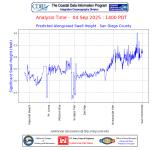MOOSE
Member
- Joined
- Nov 7, 2003
- Messages
- 624
- Reaction score
- 1
- C Dory Year
- 2001
- C Dory Model
- 22 Cruiser
- Hull Identification Number
- CD022963D101
- Vessel Name
- MOOSE
Through the marvels of the internet I was able yesterday to observe various conditions of wind and waves as a gale made its way across Lake Superior. I saw winds peak out at 44 knots and wave heights to near 15 feet. I was glad I was at home. While off-shore buoys obviously have the technology to measure wave heights accurately, it got me thinking again about how the rest of us do it.
Estimated wave heights no doubt vary with the size of one’s vessel and how frightened one is. I have had people tell me they’ve been out in ten foot waves on our large, but inland, lake. An engineer friend of mine has a program which calculates theoretical maximum wave height given the parameters of wind speed, duration, and fetch. And plugging in some very high values for each of these would indicate a potential maximum of less than five feet.
So how do most of you big-water Brats estimate wave height? Is it just a guess influenced by the pucker factor? Is it based on what you hear off the weather radio, as in “Oh, so that’s what a two-meter wave is!”? I keep looking and looking at waves and have yet to come up with a good method.
As an aside, I found a good article on wave heights at http://vos.noaa.gov/MWL/aug_05/nws.shtml It talks about the relationship between predicted wave heights and what the maximum wave height might actually be.
Al
Estimated wave heights no doubt vary with the size of one’s vessel and how frightened one is. I have had people tell me they’ve been out in ten foot waves on our large, but inland, lake. An engineer friend of mine has a program which calculates theoretical maximum wave height given the parameters of wind speed, duration, and fetch. And plugging in some very high values for each of these would indicate a potential maximum of less than five feet.
So how do most of you big-water Brats estimate wave height? Is it just a guess influenced by the pucker factor? Is it based on what you hear off the weather radio, as in “Oh, so that’s what a two-meter wave is!”? I keep looking and looking at waves and have yet to come up with a good method.
As an aside, I found a good article on wave heights at http://vos.noaa.gov/MWL/aug_05/nws.shtml It talks about the relationship between predicted wave heights and what the maximum wave height might actually be.
Al

